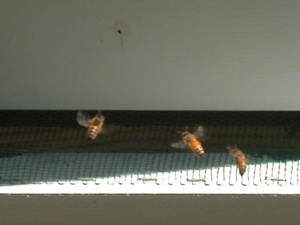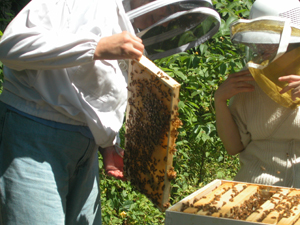 Today was a monastery bees checkup day. The colonies there have been displaying what seems to be a law of beekeeping: where one colony flourishes, another must hang back. I was wondering whether the MaryEllen and Doug colonies needed more room to expand —another medium deep, or whether there might be a problem with Doug. When I called to say I would be coming by today, I found out that additional members of the Monastery Garden Guild really wanted to participate in bee management. The picture above shows bees heading home to MaryEllen.
Today was a monastery bees checkup day. The colonies there have been displaying what seems to be a law of beekeeping: where one colony flourishes, another must hang back. I was wondering whether the MaryEllen and Doug colonies needed more room to expand —another medium deep, or whether there might be a problem with Doug. When I called to say I would be coming by today, I found out that additional members of the Monastery Garden Guild really wanted to participate in bee management. The picture above shows bees heading home to MaryEllen.I need to confess to you: having bees in three locations is very different from having all of the girls just up one flight of stairs, where I can hover and dote. It has changed the score alot, and it worries me a bit. Somehow I'm less connected to the "outyard" bees. Finally, perhaps, I'm being nudged toward a less personal and a more "herd health" attitude toward the girls, and I don't like it one bit. But each of these other colonies is more accessible to other people, and they get me in direct contact with folks who might actually decide to foster bees themselves.
 But bee-ing in these other places has gotten many more people involved, and several have become true friends of bees. Alexandra here is an officer of the Garden Guild, and she spent the better part of an hour with me today, head down in a beehive or two. Here we are checking the brood situation in MaryEllen. It is good! The Doug colony also has brood, though not quite so much, and they take less sugar syrup. The population is just building faster in MaryEllen, so they got another box today.
But bee-ing in these other places has gotten many more people involved, and several have become true friends of bees. Alexandra here is an officer of the Garden Guild, and she spent the better part of an hour with me today, head down in a beehive or two. Here we are checking the brood situation in MaryEllen. It is good! The Doug colony also has brood, though not quite so much, and they take less sugar syrup. The population is just building faster in MaryEllen, so they got another box today.This difference in energy level has been true since the start: MaryEllen's workers released their queen faster than Doug's; they have added bees and taken sugar syrup more quickly, too. The starter bees in that colony came from Wilde. The bees in Doug came from Twain, which has seemed to have endless trouble ever since.
The original bees in both these colonies are long gone, so the tendencies they display should come from their respective queens. Yet, this is not true: the trends that were in place at the beginning still prevail now. Yet another place where the bees are recognizing and responding to the world in a way that leaves humans guessing.
No comments:
Post a Comment